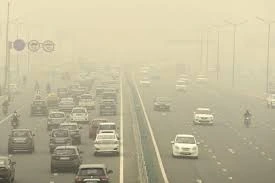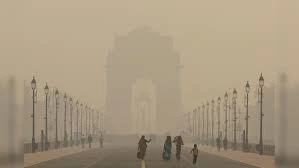Delhi Test Matches in November are sparking widespread criticism, with fans and experts pointing to high pollution levels and poor visibility as major concerns. Despite this, the BCCI has pushed ahead with the decision, drawing sharp reactions.

In addition to being reckless, the Board of Control for Cricket in India’s (BCCI) decision to hold the series’ first Test match against South Africa in New Delhi from November 14–18 verges on criminality and needs to be contested.
The BCCI may benefit from a brief introduction to air pollution and the permanent damage that polluted air can do. Playing, jogging, working out, or engaging in any other physical activity outside speeds up breathing, which raises the quantity of pollutants the lungs take in and raises the risk of illness, disability, and even early death.
Encouraging — and in this case, compelling — players by scheduling Delhi Test Matches during November is irresponsible at best and criminal at worst.
There is a distinction between lowering emissions and lowering exposure to pollutants. Pollution is caused by emissions, and pollution is bad for your health. Reducing emissions at the source is the most effective way to lower air pollution. However, there are a number of techniques to lessen pollution exposure. Certainly not one of them is playing outside in the poisonous air.
Delhi Test Matches during November raise serious health concerns, especially when experts like Dr. Maria Neira of the World Health Organisation (WHO) highlight the dangers of air pollution. She noted that over 72,000 scientific papers link air pollution to irreversible health harm. PM2.5 — particulate matter smaller than 2.5 microns — can bypass the body’s natural defenses, enter the lungs, and get absorbed into the bloodstream, potentially damaging every organ and cell in the human body, as per a comprehensive global review.
Even a typical 10-year-old in New Delhi is aware that as the monsoon season ends and the weather cools, North India’s air pollution, which is already severe throughout the year, begins to rise dramatically.
Delhi Test Matches scheduled during November are as predictably risky as the winter solstice or festivals like Diwali and Christmas — a reality BCCI secretary Devajit Saikia seems singularly unaware of, given his statement that “the pollution issue doesn’t happen every year.”
The capital has continuously remained in the “very poor” air category for the past five years, with an average November AQI of over 328, more than 20 times the WHO guidelines. As of right now, there is no indication that this will alter in November 2025.
Delhi Test Matches in November ignore a well-documented reality: the days following Diwali mark the peak of the capital’s toxic air crisis. The BCCI should already know that this is when harmful chemicals like barium, aluminium, cadmium, and sulphur from fireworks combine with existing micropollutants—PM2.5, dioxins, and microplastics—creating a deadly cocktail. Breathing this air can be more damaging to the human body than smoking cigarettes.
The BCCI is pressuring young cricket players to jeopardize their health by setting the first game three weeks after Diwali. Delhi’s air pollution would be near its yearly maximum until wind or rain clears the air of the dirty aftereffects of Diwali that are still present in the atmosphere. Let’s see how this operates.
Why pollution in Delhi peaks in October Because of the particular topography of North India—the Himalayas serve as a physical barrier to the north—poor air cannot readily dissipate, trapping pollutants created in the area.
The issue is made worse by the fact that the holiday season is also starting at this time.
At this point, weather considerations come into play. Wind speeds decrease throughout the winter months as the monsoons subside and the air gets drier and colder. Temperature inversion, which occurs when warmer, lighter air rises above cooler, denser air and traps it below, keeps the concentration of airborne particulate matter high and further limits pollution to the ground.
In North India, air pollution is a year-round problem. However, in the fall and winter, the region’s natural disasters coupled with man-made elements like firecrackers and burning crop residues create the ideal storm.
Smoke from thousands of field fires, so numerous that satellites can view them from orbit, contributes to the already high pollution load and settles closer to the earth when there is no breeze or rain. Residents of the northern plains are consequently compelled to breathe in a massive bowl of pollution for months at a time.
The BCCI expects its cricket players to inhale this poisonous air when they play in Delhi in November. The solid microparticles they inhale will remain inside their body forever. Rather, it will result in many malignancies and other non-communicable diseases, as well as damage to the respiratory, cardiovascular, neurological, and cognitive systems.
Geographical and meteorological elements are beyond our control, but the only things we can try to regulate are human-caused sources of pollution. The Supreme Court is making an effort by outright prohibiting the production and distribution of firecrackers in Delhi-NCR; nevertheless, the enforcement of this prohibition will determine whether it has any actual impact. Unless common sense wins out, the pollution season is also expected to start early this year because Diwali falls early (October 20–21).
The months of October and November are also when farmers begin to clean their fields of paddy residue from their rice harvest, even if Saikia or the BCCI are able to suppress firecrackers with the assistance of the courts and police. Burning large amounts of crop stubble in a short period of time is the fastest way to plant the rabi crop during that limited window.
According to reports, farmers in Haryana, Punjab, Rajasthan, and Uttar Pradesh produce almost 50 million tonnes of straw annually, of which around four-fifths are burned. According to more conservative estimates from the International Maize and Wheat Improvement Centre (CIMMYT), farmers in North India burn over 23 million tons of straw from their rice crops. The stack would extend from the surface of the Earth to the Moon if this massive mass of straw were stacked on top of one another in bales that were 38 cm high and weighed 20 kg each. Imagine breathing in those fumes after burning this much straw.
There is simply no prospect of a pollution-free November unless Saikia and his board can regulate all of these farms on their own, which is the second of two crucial seasonal anthropogenic elements.
Reducing emissions Vs reducing exposure

Being unable to lower emissions and, consequently, pollution is one thing. Air pollution kills 1.7 million Indians every year, with 40% of those deaths occurring in the Indo-Gangetic plains of northern India alone. This is a huge failure of government.
However, encouraging young athletes to play a fast-paced game of cricket on an open field while increasing their exposure to harmful contaminants is an entirely different level of irresponsibility. In addition, thousands of fans will be outside watching the game while breathing in PM2.5 levels that are higher than the norm for November during the past few years (except from the pandemic years), which are between 300 and 350 micrograms per cubic meter.
Delhi Test Matches in November send a dangerous message to millions of young children and aspiring sportspersons watching on television — that it’s okay to exercise, run, and play in toxic air. In a country that has already normalised pollution to alarming levels, this would be not just irresponsible, but downright dishonourable.
Delhi Test Matches continue to overlook hard-learned lessons from the past. In 2017, during a Test match between India and Sri Lanka held in the first week of December, Delhi’s average AQI was 316 — firmly in the ‘very poor’ category. On Day 2, Sri Lankan pacer Lahiru Gamage struggled mid-over due to respiratory issues, causing a 17-minute stoppage. By Day 3, the AQI soared to 390, forcing several players to wear masks on the field.
Suranga Lakmal, another quick bowler, hurried inside and puked after complaining of nausea. At one point during the game, oxygen cylinders were hurried to Sri Lanka’s dressing room because they only had ten healthy players on the field. The BCCI is taking a chance in spite of its past.
More recently, Mia Blichfeldt, a Danish badminton player who played in the January 18 India Open, complained about the awful air quality in Delhi and how it made her feel ill. I’ve been unwell at the India Open for the past two years. After returning to Denmark, she commented, “It’s really hard to accept that many weeks of work and preparation get wasted because of bad conditions.” She referred to these conditions as “unhealthy and unacceptable,” saying, “It’s not fair to anyone that we have to train and play in smog, birds shit on the courts, and dirt everywhere.”
However, the majority of sports organizations prioritize business over player health. The majority of half-marathons and marathons are conducted with little consideration for the local AQI. Organizations in the public and private sectors have equal responsibility.
Despite the high AQI, the Airtel half-marathon was held in November until a few years ago. Since then, it has been shifted to a time when the air quality is generally cleaner. Nonetheless, during the more polluted time around the end of October, the government’s own Run for Unity goes on.
Delhi Test Matches highlight the urgent need for stricter regulation around public sporting events during high pollution periods. The local administration should be barred—by the courts, if not the legislature or executive—from permitting large-scale public sporting events when the AQI exceeds 70, with this threshold reduced progressively each year. All public sporting activities, including school Sports Days typically held in winter, must be directly linked to AQI levels to safeguard public health.
Delhi Test Matches scheduled for November have even prompted concern from the Delhi and District Cricket Association (DDCA), which admitted it could face a dire situation. However, they insist they are prepared, according to a report by The Indian Express.
“The DDCA will do everything in its power to guarantee that players are at ease during the Test match. Additionally, there is additional green space surrounding the Arun Jaitley Stadium, which is situated in a rather open area. Thus, compared to most other places, the air quality is better,” DDCA secretary Ashok Sharma stated.
Delhi Test Matches: DDCA’s Pollution Denial Reflects Dangerous Normalisation
Delhi Test Matches continue to spotlight how deeply air pollution has been normalized in public discourse. DDCA’s Sharma clearly needs a deeper understanding of pollution triggers — from burning trash to post-match fireworks, any of these can rapidly worsen air quality. Despite this, Sharma stated, “Delhi had been awaiting its turn to host a Test match… We must follow the calendar because the BCCI assigned us the game. Compared to December, there is less pollution in November, if any at all.” This is yet another alarming example of how elevated pollution levels are being casually dismissed.
It’s obvious that Sharma has to learn about the causes of air pollution. There are no limits to air pollution; a strong wind, some burning trash, or even fireworks after a game is won can all swiftly raise pollution levels.
Delhi had been awaiting its turn to host a Test match, Sharma continued. It had been some time since Delhi was given a Test match. We must follow the calendar because the BCCI assigned us the game. Compared to December, there is less pollution in November, if any at all,” he stated. One further instance of the normalization of elevated pollutant levels.
In November, Dr. Vivek Nangia, the head of the Institute of Respiratory, Critical Care, and Sleep Medicine and chief pulmonologist at Max Healthcare, issued a warning about the dangers of participating in sports in New Delhi.
It is unquestionably dangerous and raises your risk of illness. Based on historical data and patterns, the AQI only increases starting in November. It reaches peak levels eventually. This will undoubtedly occur this year as well unless there is a miracle or a significant effort to cut emissions and pollution. We encourage people not to exercise outside when pollution levels are high. The reason is that exercise causes your breathing to deepen and speed up. Thus, you wind up breathing in two or three times as much pollution as you otherwise would,” Dr. Nangia continued.
According to the World Air Quality Report for 2024, which was published last month, Delhi has the shame of being the most polluted national capital in the world for the sixth consecutive year. At the very least, let’s avoid giving the impression that we don’t care about our inhabitants, visitors, or young athletes.















